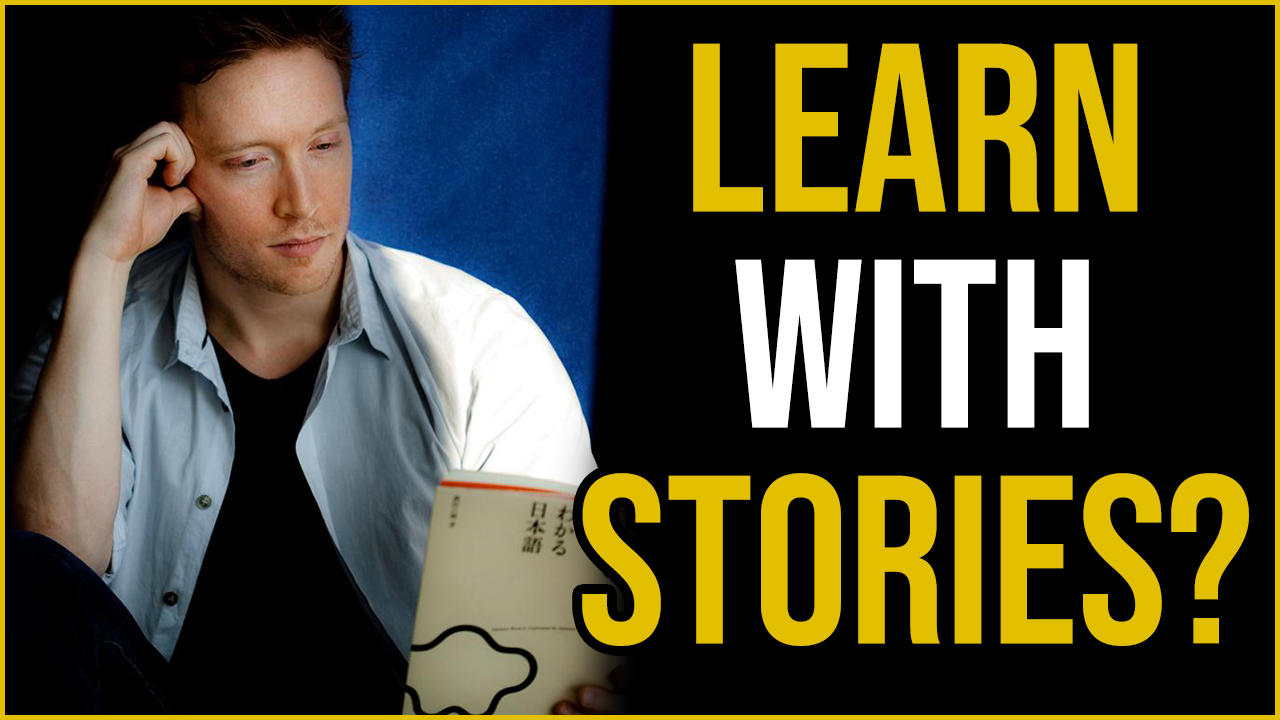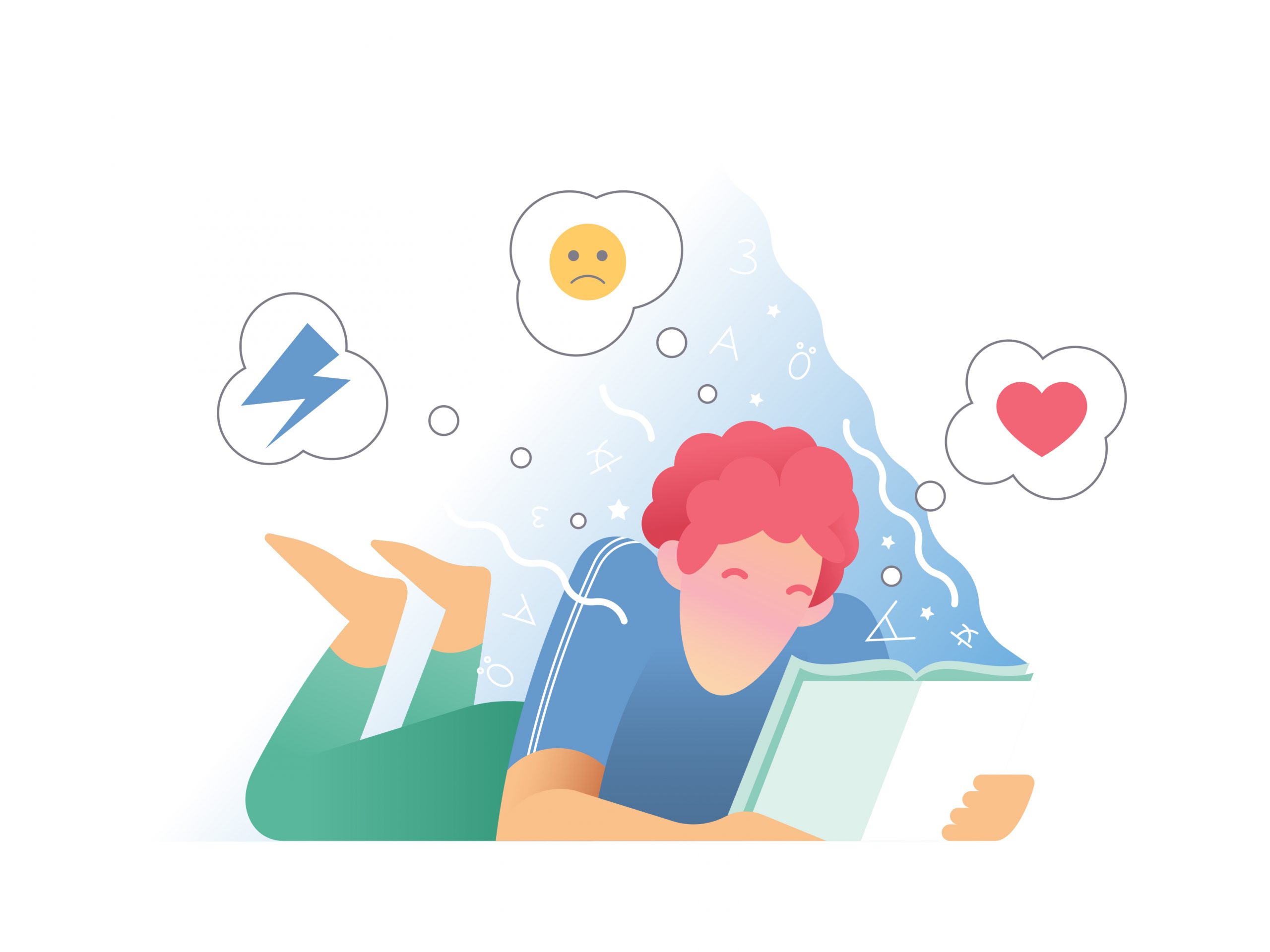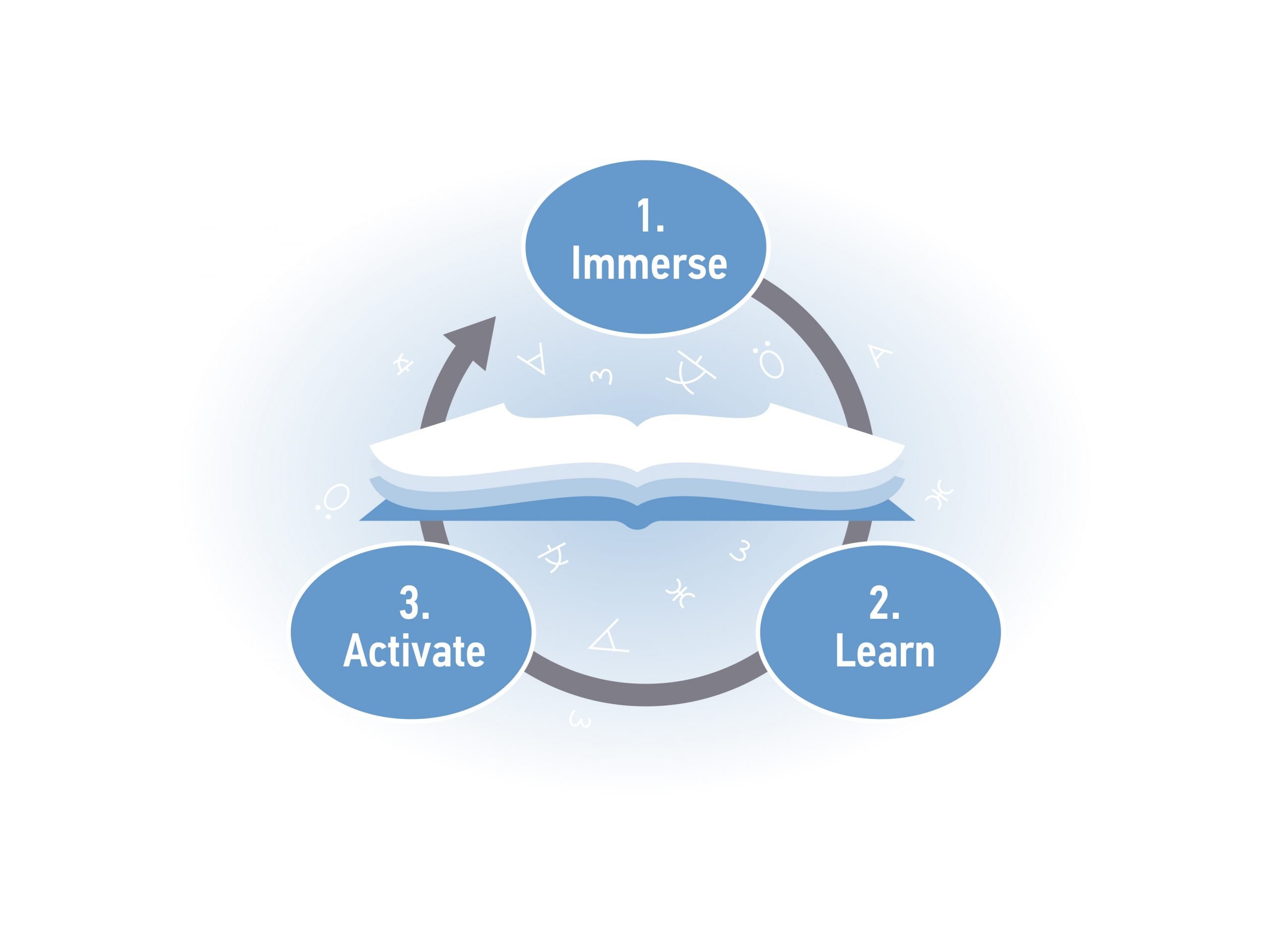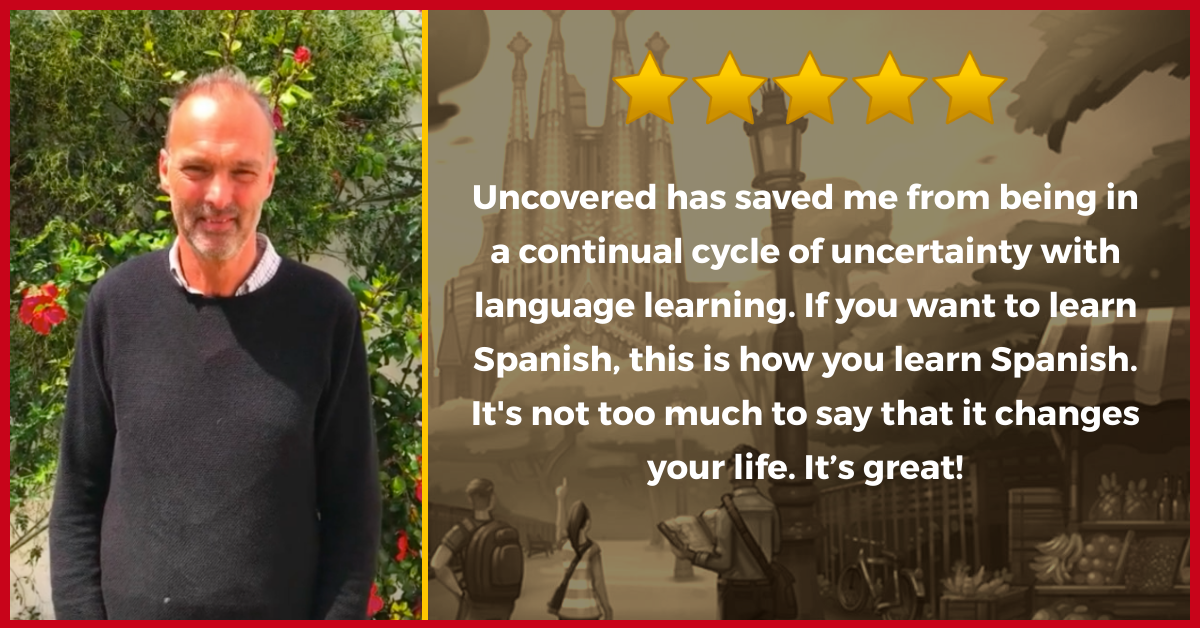
StoryLearning® is an exciting, new way of learning foreign languages. With the StoryLearning method, you learn languages quickly – through stories, not rules.
Table Of Contents
Part 2 – Stories and Language Learning
- What Makes Stories Good For Language Learning?
- The StoryLearning Method
- The Theory of Language Acquisition
Part 3 – StoryLearning Courses
Introduction
Traditionally, languages are taught with textbooks, classroom lectures and tests, but what if that isn’t the best way to learn languages? What if you don’t learn languages by deliberately studying them? What if, instead, you learn languages by reading and listening to stories?
With StoryLearning, your main focus is on reading stories. As you read, you learn the language. This is a natural way of learning. It helps you think in the language, and is how children learn their native languages.
When you learn through StoryLearning, you will see exciting results:
- Remember words easily – The brain remembers more vocabulary from a story, because you are motivated to understand what you are reading
- Learn grammar naturally – When you see grammar being used over and over to tell a story, your brain will begin to understand how it works. Instead of learning rules, you simply get used to how grammar works from the story
- Understand people easily – The StoryLearning method involves simultaneous listening and reading, which quickly helps you understand the spoken language
- Motivation – Stories are enjoyable, which motivates you to learn every day.
- Control of your learning – When you learn through stories, and read for pleasure, you become an independent learner. When you are in control of your own learning, you can learn a new language quickly
With the deep, native-like knowledge you get from StoryLearning, you can learn any language quickly.
If you’re ready to get started, click the button below to find the best course for you:
Praise for Olly's StoryLearning Method
“Olly’s advice on language learning is the real deal, and I recommend you pay attention to what he has to say!” – Benny Lewis, Fluent in 3 Months
Otherwise, let’s dive into the magic, and the science, of stories!
Part 1 – The Magic Of Stories

How We Use Stories
Storytelling is our oldest form of communication. From early cave drawings to hieroglyphics in Ancient Egypt, we have used stories to entertain, educate, preserve culture and teach moral values.
In the modern world, stories are all around us. Some of the stories we tell are thousands of years old. Other stories we invent for new purposes.
- Entertainment – Novels, comics, TV & movies and video games tell stories of all kinds
- Business – Companies use stories to generate interest in their products in a less direct way than a blatant sales pitch
- Politics – Politicians make use of stories to connect with voters emotionally, and, in extreme cases, even rewrite stories from history in an attempt to shape the future
- Psychology – In therapeutic settings, patients are encouraged to explore their own story in order to better understand themselves
- Religion – Religious groups use stories and parables to convey their beliefs, moral codes, or even words directly from God
How We Use Stories In Education
Given how much storytelling is around us, it is no wonder that stories are also widely used for learning and teaching:
- School – Great novels are required reading in schools as they teach important lessons about life
- Church – Religious institutions use stories to teach children about behaviour and morals
- Parents – Parents tell children stories to teach them about the world – feelings and emotions, the perspectives of others, morals, good behaviour and more
- University – Harvard Business School teaches business using the Case Study Method – stories about the successes and failures of other business
We use stories to make learning more effective. Lessons from stories are more powerful and memorable, because the learner can relate the stories to their own lives.
Stories And The Brain

The effects of stories can be measured in the brain. Stories activate parts of your brain that are not engaged in fact-based learning:
- Left temporal cortex – used for understanding language and remembering verbal information (Language learners take note!)
- Frontal and parietal cortices – the parts of the brain involved in association of ideas, memory and attention
- Auditory cortex – A part of the brain involved in learning and memory, found to be larger in bilingual people
Learning with stories mixes rational information with experiential parts of brain, forming neural connections. When repeated, neural connections are strengthened. Stronger neural connections result in longer-term memory.
Scans show that brain activity from a story can last for days, which explains why what you learn from stories is lasts longer than in traditional learning. In fact, the psychologist Jerome Bruner is known for suggesting that we are 22 times more likely to remember facts that are given in a story.
Overall, learning through story results in a powerful cocktail of meaning, memory and emotion. It is quite different from plain facts, which are so easily forgotten.
If you’re ready to get started, click the button below to find the best course for you:
Praise for Olly's StoryLearning Method
“Olly’s top-notch language-learning insights are right in line with the best of what we know from neuroscience and cognitive psychology about how to learn effectively. I love his work—and you will too!” – Dr. Barbara Oakley, Author Of NYT Best-seller: A Mind For Numbers
Stories are effective for learning due to three factors:
- Context – Stories place message in the context of our world, making them relevant and easy to understand
- Meaning – It is easier to draw tangible lessons from relatable events in a story, than from theory or raw facts
- Emotion – Stories engage you on an emotional level, which makes the lessons more memorable
Part 2 – Stories In Language Learning

In part one, we saw how stories are used and the science behind what makes stories effective for learning. But what makes stories such a powerful way to learn foreign languages in particular?
What Makes Stories Good For Language Learning?
To begin, remember that learning a language does not just mean learning new words or grammar rules. Knowing a language means understanding the culture, and being able to interact with others. When you learn with stories, you don’t just learn a language, you learn to use the language.
Existing world knowledge
When you learn with stories, you begin with a language you already understand – the universal language of story. Learning a new language means learning a new set of tools for expressing ideas. And if you already understand the ideas themselves, the tools will be much easier to learn.
Meaning
The biggest pull when reading a story is to discover what happens next. So, learning with stories means you to focusing on the events of the story, instead of the grammar of the language. This focus on meaning, helps you communicate in the language from the start.
Context
In stories, every word appears in context. You are more likely to learn the correct way to use a word if you see it in context, especially if the new word is important to the story. Important words and grammar patterns are regularly repeated in stories, giving you many opportunities to learn them.
Motivation
A good story should keep you interested and engaged, and figuring out whodunit is one of the ultimate motivators to keep reading. So, stories give you a reason to keep learning. If you struggle to be motivated by an end-of-term grammar test, stories offer a motivating alternative, by adding colour and zest to your learning.
Cultural literacy
Understanding the local culture is just as important as learning the language itself. Stories teach lessons about culture through the events of the story and the interaction between the characters. Learning with stories helps you become literate in the culture of the language.
Response
When you read a good story, you have a personal reaction to the story. Whether positive or negative, a reaction is a human response. So, by learning a foreign language through story, and becoming emotionally involved, you are making the language a more authentic part of your life.
Learning through story is no longer just black and white information on the pages of a textbook. Every detail of the language appears in glorious colour. Stories allow you to focus on communication, and lead to a deep, powerful knowledge of the language, in just the same way as children learn their first language.
The StoryLearning Method
So far, we have looked at the theory of why stories are effective for learning. In this section, you will learn how to apply these principles to learn languages with the StoryLearning method.
With the StoryLearning method, you learn languages quickly through stories, not rules. To do this, you follow a simple three-step process:
- Step 1: Immerse – Immerse yourself in the language with a story
- Step 2: Learn – Learn words, phrases and grammar by uncovering them from the story
- Step 3: Activate – Activate what you learn with exercises based on the story

Step 1: Immerse
Immerse yourself in the language with a story
StoryLearning courses are built around a story. With each chapter of the story, you learn more of the language. You start by reading and listening to the story. The story is expertly written to be suitable for your level, so it’s not too hard.
Unlike traditional methods, we don’t ask you to learn or memorise anything from the story. We don’t even ask you to understand everything you read at first. You simply enjoy immersing yourself in the language, without feeling like you're studying at all!
Step 2: Learn
Learn words, phrases and grammar by uncovering them from the story
After immersing yourself in the story, it’s time to learn. Imagine you had a native speaker standing over your shoulder, pointing out useful words and grammar as you read the story:
- Words explained
- Sentences made clear
- Questions answered
Using modern teaching techniques and master teachers, you learn words, phrases and grammar from the story, in an easy-to-understand way. With our “story first” approach, you'll find that new words stick more easily and that your brain learns grammar intuitively. Forget rote memorisation and grammar drills… this is natural learning at its best!
Step 3: Activate
Activate what you learn with exercises based on the story
After reading, listening and learning, you’re ready for our creative exercises that help you activate what you have learned, test your knowledge and track your progress.
You will find:
- Worksheets to help you try out and review what you’ve learned
- Creative tasks to use what you’ve learned in real situations
- Quizzes to test your knowledge and track your progress
Unlike traditional learning, all StoryLearning activities are based on the story itself. This means that you are not just ‘rote learning’, but reinforcing everything you have already learned. This means you learn it more deeply, and remember it for longer!
If you’re ready to get started, click the button below to find the best course for you:
Praise for Olly's StoryLearning Method
“Olly bridges the gap between theory and practice by helping you to use scientific principles to get real results with your language learning.” – Anthony Metivier, Magnetic Memory Method
The Theory Of Language Acquisition
Now you know how the StoryLearning method works, you may be interested in the theory behind it. After all, StoryLearning is based on decades of academic research into second language acquisition. This section is more technical, but will explain the science behind the learning.
Comprehensible Input
At the core of the StoryLearning method is the idea that you learn a new language by reading and listening to stories. This is known as an “input method”. An input method means that you learn not from deliberate study, but by reading and listening to material that you want to understand – in this case, stories.
Reading and listening to material that you want to understand requires that you have such material at the right level for you. Specifically, the stories should be at a level where you are able to understand what’s going on – the gist of the plot. Material at this level is known as “comprehensible input”.
“The best methods are therefore those that supply “comprehensible input” in low anxiety situations, containing messages that students really want to hear.” – Dr. S. Krashen, 2009, Principles and Practice in Second Language Acquisition.
All StoryLearning programmes offer material that is based on comprehensible input. The experience is like reading your favourite author in a different language, and being able to understand it!
Extensive Reading
With StoryLearning, you will practice what is known as “extensive reading”. Extensive reading means reading for pleasure, and the main objective is to focus on the enjoyment of reading in the target language.
As the name suggests, this means reading a lot of material – far more than you may be used to in the short dialogues commonly found in language textbooks. By reading extensively, you give your brain a chance to get used to the language and notice patterns naturally.
This means that when you learn with StoryLearning, you can expect to read more than you are used to… even as a beginner! However, far from being daunting, students find this exhilarating, because they are able to understand and enjoy what they read, leading to excitement and increased motivation. (As mentioned earlier: “Comprehensible input in low anxiety situations.”)
Read And Listen

Learning to understand a new language involves two forms of input: reading and listening. Reading is a more convenient form for learning, as you can see the language on paper, word for word. However, listening is also essential if you want to be able to understand people when they speak.
People often consider reading and listening to be separate skills. However, reading and listening at the same time has many benefits, such as learning to understand the spoken language, better pronunciation and remembering vocabulary more easily.
Best of all, though, is the fact that combining the two activities takes no extra time. You get much more bang for your buck with every hour of study you do. However, it is extremely difficult to find material in foreign language that comes with the audio and the text together.
That’s why, in StoryLearning we have a golden rule: Everything we produce comes with both text and audio. This means you always have everything you need to learn effectively, without having to dig around for supplementary material.
Focus On Form
Learning through stories is effective because it engages different parts of the brain. However, part of learning effectively means engaging the whole brain, and that includes the more logical and analytical parts of the brain.
Therefore, a small amount of more traditional study can still be helpful, and speed up the learning process, especially for adult learners. (This is known as “focus on form”.)
For example, familiarity with the so-called “rules” of a particular grammar point will help you learn it faster, as your logical brain can help spot patterns faster.
In StoryLearning, our approach to focusing on form is to cleverly embed things you need to learn inside the story wrapper. We take an approach known as “guided discovery”, where we use the contents of the story to help you notice the target language faster.
StoryLearning will always guide you towards noticing the important language, just as if you had a teacher standing over your shoulder.
Deliberate Practice
Just like with focus on form, some deliberate practice can also be helpful in the learning process. For example, some people find practice exercises or speaking activities to be helpful in focusing the brain, consolidating what they have learnt, or as a tangible measure of their progress.
However, these kinds of activities are optional and are not central to the method. This is quite different to mainstream language methods, and most apps for that matter, where students are expected to immediately demonstrate what they have learnt in spoken or written exercises.
In the StoryLearning method, we provide a small number of holistic practice exercises and activities that aim to engage the whole brain, and are always related to the topic of the story, thereby creating even more repetition of vocabulary and language patterns.
If you’re ready to get started, click the button below to find the best course for you:
Praise for Olly's StoryLearning Method
“Learning a language is challenging, but it’s one of the best things you can do for your brain and your learning skill set… Olly Richards is doing some seriously incredible work to empower more and more people to rise to the challenge.” – Jonathan Levi, Author & Learning Expert
Part 3 – StoryLearning Courses

Now that you know how the StoryLearning method works, it’s time to see the method in practice!
We use StoryLearning to teach many languages, at many different levels, in many different ways.
In fact, this is the wonderful thing about StoryLearning – whatever stage of learning you are at, you can always use this method to improve. In fact, you can learn from beginner to fluent using only StoryLearning!
Here is an overview of the StoryLearning programme we offer:
StoryLearning Courses
Our complete StoryLearning courses come in a variety of formats. You will find complete beginner courses, to learn a new language from scratch. You will also find more advanced courses to improve an existing language in a targeted way:
- Uncovered (beginner) – The complete beginner programme to learn a new language through the power of story.
- Conversations (intermediate) – Learn to effortlessly understand native speakers in conversation.
- Grammar Hero (intermediate) – Master the grammar of your new language.
StoryLearning Books
Our beautiful StoryLearning books are designed to inspire you to fluency! The books help you read for pleasure at your level, so you can form a lifelong passion for reading in your new language. All books come in paperback, digital and audio versions, so you always have them with you, and can continue learning wherever you are:
- Short Stories (beginner, intermediate) – Read for pleasure at your level and learn a new language the fun way.
- 101 Conversations – Short, natural dialogues to improve your speaking from home.
- 30-Day Mastery – Short, intensive reading programmes to improve your new language.
To find out more about any of our courses, click the “Explore” links above.
Alternatively, click the button below to find the best course for you:
Praise for Olly's StoryLearning Method
“When we wanted to create an online course on how to learn a language we asked Olly to write it with us. His experience has been invaluable.” – Dr. Tita Beaven, The Open University
I hope you have enjoyed reading about StoryLearning, and that it has inspired you to try the method for yourself!
I’ll leave you with the words of one of our thousands of students, so you can see what it feels like to learn a new language through the magic of story!


What Do Students Say About StoryLearning?

Ready to get started? Click the button below to find the best course for you:









































